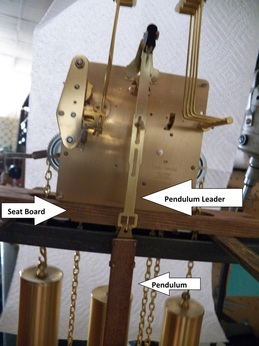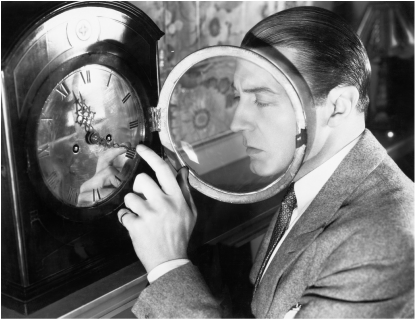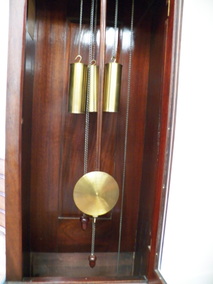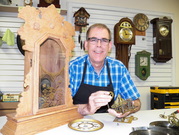|
I have had several customers ask me this. Sometimes they have been told by “clockmakers” that adding bushings will devalue the clock. These same “clockmakers” then proceed to take a prick punch and scar up the movement with abandon. What is the truth about bushings?
A clock in mint condition is always more valuable that a clock in excellent condition. That is because mint means it is in the exact condition it was when it was made, or “new and in the box.” Mint condition clocks are more valuable because they are so rare. A mint condition clock will have no wear, so it will have no need for bushings. Adding bushings to a mint condition clock would decrease the value of the clock because the clock would no longer be in the condition it was in when it was made. Most antique clocks have been used, but they may still be in very good condition. However after 100, 200, or 300 years of use, some wear is bound to occur. Repairs are expected, and well done repairs do not detract from the value of the clock. Bushings are recognized by the American Watchmakers-Clockmakers Institute as the best method for correcting worn pivot holes.
4 Comments
The easiest way to find the proper key is to bring the clock in to a local clock shop. A good repair shop should have a selection of key in stock and can probably supply the key you need. If you are near Mount Vernon, WA, you are welcome to bring the clock into my shop. You can also use the American Watchmakers – Clockmakers Institute website, https://members.awci.com/AWCIWEB/AWCISearch/MemberSearch.aspx, to find a repair center near you.
Some people do not have a repair shop within a reasonable distance from them. In that case you can order a key yourself. Use a pair of calipers to measure the small timekeeping adjustment arbor and also the winding arbors (in millimeters). Harbor Freight has a cheap pair of digital calipers that will work just fine for this purpose. Once you have the required measurements, you can search for the appropriately sized double ended key on one of the clock supply websites. Ronell Clocks, Timesavers, and Merritt’s Antiques all carry double ended clock keys. Be aware that the stated sizes of the keys and the size you measure on the arbor may be slightly different, so you may need to order more than one key to get one that fits. Fortunately, they are relatively cheap. Your key should slide easily onto the arbor, but not so loose that either the key or the corners of the winding arbor can be damaged when you turn the key. Good luck! Please note: In this article we use the word "chime" to refer to the melody a clock plays as it marks the quarter hours and "strike" to refer to the bonging sound a clock makes when it counts the hours. When properly chiming, the traditional Westminster chimes plays four descending notes on the first quarter-hour, eight notes on the second quarter-hour, twelve notes on the third quarter hour and 16 notes on the hour. After the clock chimes on the hour, it should then strike the number of hours. To troubleshoot:
First let’s talk about what can go wrong in a move. The number one problem that I observe is broken chime rods, followed by pendulum problems (broken suspension springs or dislocated pendulum leaders), and weight problems (weight chains that are off their sprockets, or tangled weight cables). Here are the steps I use when packing a clock to ship for moving: 
Once you have immobilized the pendulum, tape it securely to that backboard of your clock case, using painter’s tape. After your move, be sure to remove the tape as soon as possible to prevent damaging the wood finish.
3. Secure the pendulum leader: For grandfather clocks, use painter’s tape to tape the pendulum leader to the seat board or to the case. 4. Secure any chains or cables: If the weights hang from chains such as with cuckoo clocks and some grandfather clocks, you need to keep the chains from jumping off the sprockets during the move. To do this, insert a thin piece of wire or a twist tie through the links of each chain Yes, you can. However, the process is somewhat complicated, and involves removing the clock movement from the case, as well as using specially formulated oil. Because of this, many people prefer to have their clock oiled professionally.
Here are some tips for oiling your clock yourself:
The American Watchmakers–Clockmakers Institute recommends that clocks be oiled every three to four years and cleaned every ten. Cleaning involves taking the clock apart, cleaning the parts individually, and re-assembling them, then oiling the clock with special clock oil. Clocks that are regularly cleaned and oiled need to be overhauled (repaired) much less frequently. Regular cleaning and oiling will keep a clock in better shape for a longer time, just as regular tune-ups provide preventive maintenance for a car. 3-10 Rule:
Oil every 3 years; Clean every 10 Pendulum Clocks
These clocks keep time by counting the number of swings of the pendulum. Shorter pendulums swing faster than longer ones do. To speed up a clock you must make the effective length of the pendulum shorter; to slow down the clock, the pendulum length must be longer. There are two main ways to do this....
Clocks made after World War II
The time on post-World War II clocks can usually be set by moving the minute hand either clockwise or counter-clockwise. If you move the minute hand counter-clockwise, the clock will take up to an hour to re-sequence its chimes. While it is re-sequencing itself, the clock will not strike the quarter hours. Once the minute hand passes the top of the hour ("12") it should chime correctly again.
Over-winding will not cause a clock to stop. If a clock stops when it is fully wound, it is an indicator that there are other serious problems. Having said that, don’t try to wind a clock past where you feel it stop winding. You can stress the mainspring, and eventually it may break.
|
Mike SarchetI am passionate about restoring and repairing antique clocks. In this blog I answer commonly asked questions about how to care for your clock. Frequently Asked Questions:
|
|
Email: mike@wiseowlclock
repair.com |
|




